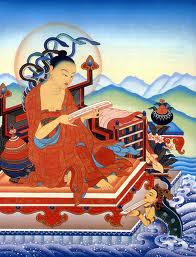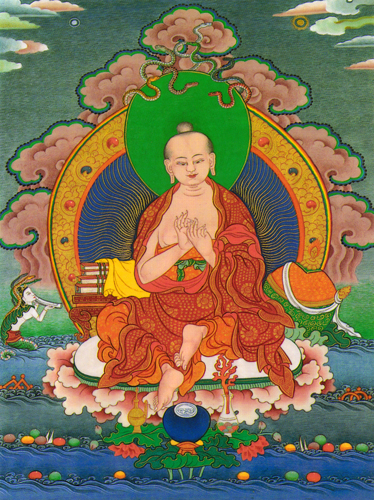
Precious little is known about the actual life of the historical Nagarjuna. The two most extensive biographies of Nagarjuna, one in Chinese and the other in Tibetan, were written many centuries after his life and incorporate much lively but historically unreliable material which sometimes reaches mythic proportions.
However, from the sketches of historical detail and the legend meant to be pedagogical in nature, combined with the texts reasonably attributed to him, some sense may be gained of his place in the Indian Buddhist and philosophical traditions.
Nagarjuna was born a “Hindu,” which in his time connoted religious allegiance to the Vedas, probably into an upper-caste Brahmin family and probably in the southern Andhra region of India. The dates of his life are just as amorphous, but two texts which may well have been authored by him offer some help.
These are in the form of epistles and were addressed to the historical king of the northern Satvahana dynasty Gautamiputra Satakarni (ruled c. 166-196 CE), whose steadfast Brahminical patronage, constant battles against powerful northern Shaka Satrap rulers and whose ambitious but ultimately unsuccessful attempts at expansion seem to indicate that he could not manage to follow Nagarjuna’s advice to adopt Buddhist pacifism and maintain a peaceful realm. At any rate, the imperial correspondence would place the significant years of Nagarjuna’s life sometime between 150 and 200 CE.
Tibetan sources then may well be basically accurate in portraying Nagarjuna’s emigration from Andhra to study Buddhism at Nalanda in present-day Bihar, the future site of the greatest Buddhist monastery of scholastic learning in that tradition’s proud history in India. This emigration to the north perhaps followed the path of the Shaka kings themselves. In the vibrant intellectual life of a not very tranquil north India then, Nagarjuna came into his own as a philosopher.
The occasion for Nagarjuna’s “conversion” to Buddhism is uncertain. According to the Tibetan account, it had been predicted that Nagarjuna would die at an early age, so his parents decided to head off this terrible fate by entering him in the Buddhist order, after which his health promptly improved. He then moved to the north and began his tutelage.
The other, more colorful Chinese legend, portrays a devilish young adolescent using magical yogic powers to sneak, with a few friends, into the king’s harem and seduce his mistresses. Nagarjuna was able to escape when they were detected, but his friends were all apprehended and executed, and, realizing what a precarious business the pursuit of desires was, Nagarjuna renounced the world and sought enlightenment.
After having been converted, Nagarjuna’s adroitness at magic and meditation earned him an invitation to the bottom of the ocean, the home of the serpent kingdom. While there, the prodigy initiate “discovered” the “wisdom literature” of the Buddhist tradition, known as the Prajnaparamita Sutras, and on the credit of his great merit, returned them to the world, and thereafter was known by the name Nagarjuna, the “noble serpent.”
Despite the tradition’s insistence that immersion into the scriptural texts of the competing movements of classical Theravada and emerging “Great Vehicle” (Mahayana) Buddhism was what spurred Nagarjuna’s writings, there is rare extended reference to the early and voluminous classical Buddhist sutras and to the Mahayana texts which were then being composed in Nagarjuna’s own language of choice, Sanskrit.
It is much more likely that Nagarjuna thrived on the exciting new scholastic philosophical debates that were spreading throughout north India among and between Brahminical and Buddhist thinkers. Buddhism by this time had perhaps the oldest competing systematic worldview on the scene, but by then Vedic schools such as Samkhya, which divided the cosmos into spiritual and material entities, Yoga, the discipline of meditation, and Vaisesika, or atomism were probably well-established.
But new and exciting things were happening in the debate halls. A new Vedic school of Logic (Nyaya) was making its literary debut, positing an elaborate realism which categorized the types of basic knowable things in the world, formulated a theory of knowledge which was to serve as the basis for all claims to truth, and drew out a full-blown theory of correct and fallacious logical argumentation.
Alongside it, within the Buddhist camp, sects of metaphysicians emerged with their own doctrines of atomism and fundamental categories of substance. Nagarjuna was to undertake a forceful engagement of both these new Brahminical and Buddhist movements, an intellectual endeavor till then unheard of.

Nagarjuna saw in the concept sunya, a concept which connoted in the early Pali Buddhist literature the lack of a stable, inherent existence in persons, but which since the third century BCE had also denoted the newly formulated number “zero,” the interpretive key to the heart of Buddhist teaching, and the undoing of all the metaphysical schools of philosophy which were at the time flourishing around him.
Indeed, Nagarjuna’s philosophy can be seen as an attempt to deconstruct all systems of thought which analyzed the world in terms of fixed substances and essences. Things in fact lack essence, according to Nagarjuna, they have no fixed nature, and indeed it is only because of this lack of essential, immutable being that change is possible, that one thing can transform into another. Each thing can only have its existence through its lack (sunyata) of inherent, eternal essence.
With this new concept of “emptiness,” “voidness,” “lack” of essence, “zeroness,” this somewhat unlikely prodigy was to help mold the vocabulary and character of Buddhist thought forever.
Armed with the notion of the “emptiness” of all things, Nagarjuna built his literary corpus. While argument still persists over which of the texts bearing his name can be reliably attributed to Nagarjuna, a general agreement seems to have been reached in the scholarly literature.
Since it is not known in what chronological order his writings were produced, the best that can be done is to arrange them thematically according to works on Buddhist topics, Brahminical topics and finally ethics.
Addressing the schools of what he considered metaphysically wayward Buddhism, Nagarjuna wrote Fundamental Verses on the Middle Way (Mulamadhyamakakarika), and then, in order to further refine his newly coined and revolutionary concept, the Seventy Verses on Emptiness (Sunyatasaptati), followed by a treatise on Buddhist philosophical method, the Sixty Verses on Reasoning (Yuktisastika).
Included in the works addressed to Buddhists may have been a further treatise on the shared empirical world and its establishment through social custom, called Proof of Convention (Vyavaharasiddhi), though save for a few cited verses, this is lost to us, as well as an instructional book on practice, cited by one Indian and a number of Chinese commentators, the Preparation for Enlightenment (Bodhisambaraka).
Finally is a didactic work on the causal theory of Buddhism, the Constituents of Dependent Arising (Pratityasumutpadahrdaya).
Next came a series of works on philosophical method, which for the most part were reactionary critiques of Brahminical substantialist and epistemological categories, The End of Disputes (Vigrahavyavartani) and the not-too-subtly titled Pulverizing the Categories (Vaidalyaprakarana).
Finally are a pair of religious and ethical treatises addressed to the king Gautamiputra, entitled To a Good Friend (Suhrlekha) and Precious Garland (Ratnavali). Nagarjuna then was a fairly active author, addressing the most pressing philosophical issues in the Buddhism and Brahmanism of his time, and more than that, carrying his Buddhist ideas into the fields of social, ethical and political philosophy.
It is again not known precisely how long Nagarjuna lived. But the legendary story of his death once again is a tribute to his status in the Buddhist tradition.
Tibetan biographies tell us that, when Gautamiputra’s successor was about to ascend to the throne, he was anxious to find a replacement as a spiritual advisor to better suit his Brahmanical preferences, and unsure of how to delicately or diplomatically deal with Nagarjuna, he forthrightly requested the sage to accommodate and show compassion for his predicament by committing suicide.
Nagarjuna assented, and was decapitated with a blade of holy grass which he himself had some time previously accidentally uprooted while looking for materials for his meditation cushion. The indomitable logician could only be brought down by his own will and his own weapon. Whether true or not, this master of skeptical method would well have appreciated the irony.
Source:
http://www.iep.utm.edu/nagarjun/
http://www.meditationincolorado.org/nagarjuna.htm









































 English
English Indonesia
Indonesia Tibetan
Tibetan
Dr. K. Jamanadas
December 6, 2010
Sir,
Nagarjuna is described as IDEALIST, is that fair? Did he believe in SOUL? Did he believe in GOD? Did he believe in authority of shastras (VEDAS)? If not, how can he be termed as Idealist, as is done by some scholars as Debiprasad Chattopadhyaya?
Thanks!
Dr. K. Jamanadas
[email protected]
Sarah
January 29, 2011
There is a translation and commentary by Jay L. Garfield titled “The Fundamental Wisdom of the Middle Way” published in 1995 which makes it easy for students to understand this fascinating philosophical work due to its use of contemporary philosophical language. The Mulamadhyamakakarika has been interpreted many times, usually from the standpoint of the interpreter’s own religious tradition or his/her own philosophical interest.
Personally I find the Dalai Lama’s teachings on “The Precious Garland” and Lama Tsongkhapa’s epistolary poem “The Three Principles of the Path” very helpful in understanding the fundamental aspects of Mahayana Buddhism.
Rinchen
August 8, 2013
It is just great how Nagarjuna survived what is being predicted of his life. I believe it is because of the merits that he has gained after practicing Buddhism that extended his life. It is just great to hear that through Buddhism, it has helped Naharjuna.
It is great that Nahajurna has written some articles that would benefit others in the spiritual paths that they are heading towards.